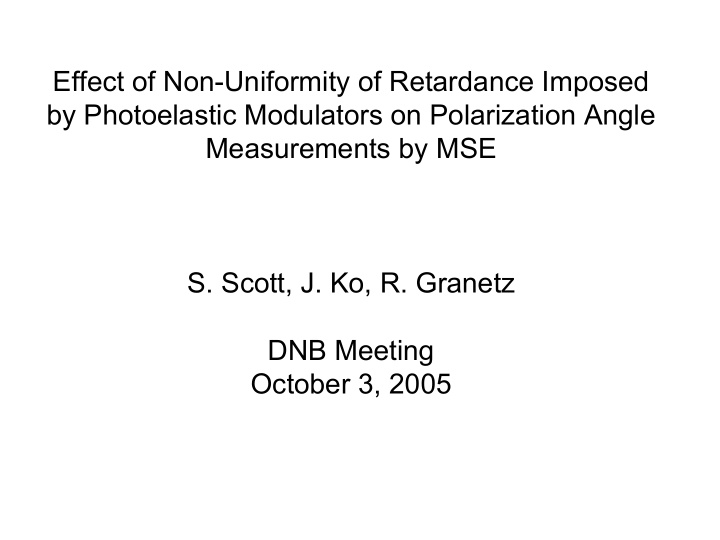



Effect of Non-Uniformity of Retardance Imposed by Photoelastic Modulators on Polarization Angle Measurements by MSE S. Scott, J. Ko, R. Granetz DNB Meeting October 3, 2005
Motivation • The maximum retardance imposed by a photoelastic modulator is a function of position across the crystal surface. • Most MSE systems use only the center of the PEM, so as to get a constant retardance for all rays. • The C-Mod MSE system uses much more of the PEM surface, due to other constraints in the optical design. • We see changes in the measured polarization direction as a small light source is moved around, within the nominal viewing area of an MSE channel on C-Mod. • Are these changes caused by variations in the retardance imposed by the PEMs?
Motivation • The maximum retardance imposed by a photoelastic modulator is a function of position across the crystal surface. • Most MSE systems use only the center of the PEM, so as to get a constant retardance for all rays. • The C-Mod MSE system uses much more of the PEM surface, due to other constraints in the optical design. • We see changes in the measured polarization direction as a small light source is moved around, within the nominal viewing area of an MSE channel on C-Mod. • Are these changes caused by variations in the retardance imposed by the PEMs?
Configuration: scans 20 and 21 circular diffuser LED array mask with alignment target cardboard 4mm hole (removed during shroud angle measurements) fan support moves left, right MSE and up, down to position wire grid Lens L1 spot of light polarizer Optical table along DNB trajectory
Change in Measured Polarization Angle (MSE frame) using Wire Grid Polarizer Spot Positions Channel 0 Channel 4 1b 1c 1d 0.28 0.71* 0.91 0.29** 0.15*** 0.11 2c -0.06 0.11 3c 0.40 0.03 4b 4c 4d 0.36 0.00 0.26 0.26 0.0 -- 5c 0.06 0.25 6c 6b 6d 0.16 0.40 0.31 -0.43 0.43 -0.13 Channel 0: MSE scan 20, shots 1050928100-113 (analysis try 2) standard deviation = 0.35 o . Channel 4: MSE scan 21, shots 1050928114-117, 128-134, 136-139 (analysis try 2) standard deviation = 0.17 o . Signal strength for “edge” spots (positions b and d) is lower than “central” spots by factor 4-5. Measurement precision for channel 0 is about 0.015 o for “c” position and 0.03 o for “b/d” positions. Angle differences are defined relative to position 4c. Actual values for 4c = -6.19 o (channel 0) and -4.99 o (channel 4). * Average of 0.70, 0.72 ** Average of 0.26, 0.30, 0.30 *** Average of 0.12, 0.18
Configuration: scan 30 mask with 4mm hole circular diffuser precision linear LED array polarizer alignment target cardboard (removed during shroud angle measurements) fan support moves left, right MSE and up, down to position Lens L1 spot of light Optical table along DNB trajectory
Scan 30: Measured Angle in Channel 0 is a Smooth & Reproducible Function of Spot Position of Masked Light Source 0.0 -0.2 Measured Angle (pa_0) -0.4 -0.6 same position -0.8 same position -1.0 -1.2 105 110 115 120 125 shot-1050929000. Note: small left-right effect. LOCUS: sds11
Ray Tracing Indicates that Light from Different Spots within Viewing Area of Channel 0 Intersects PEMs at Different Positions Upper Left (PEM-1) Upper Right Median: -6.2, -3.3 mm Median: -7.7, -4.3 mm Lower Right Lower Left Median: -2.7, -6.8 mm Median: -3.8, -8.1 mm Courtesy: J. Ko
Ray Tracing Also Shows Variations in Position of Optical Rays at PEM-2 Upper Right Upper Left (PEM-2) Median: -9.4, -4.6 mm Median: -11.3, -6.1 mm Lower Right Lower Left Median: -4.2, -9.9 mm Median: -5.8, -11.6 mm Courtesy: J. Ko
Position on PEM affects Maximum Imposed Retardance Retardance Affects Measured Polarization Angle • Retardance is quadratic along one PEM axis, and independent of position along the other axis. • tan (2 γ ) = J o (A o ) A40 / J o (B o ) A44. • Assuming that the quadratic axis is the second dimension in the median values computed in the previous plots, the expected change in angle among the four spot positions is 1.4 degrees … in good agreement with the measured differences. • So we expect variations of order a degree in the measured polarization direction for light emitted from various spots within the viewing area of channel 0. • The effect on polarization measurements that use the whole viewing area will be considerably smaller, due to averaging. • Variations will be caused by changes in the (mostly vertical) intensity distribution within the viewing area of a channel, e.g. shot-to-shot, or beam-into-gas vs LED. • My guesstimate: averaging will reduce this effect by 1-2 orders of magnitude for beam-into-gas versus beam-into-plasma.
Recommend
More recommend